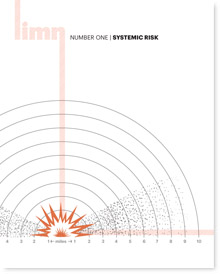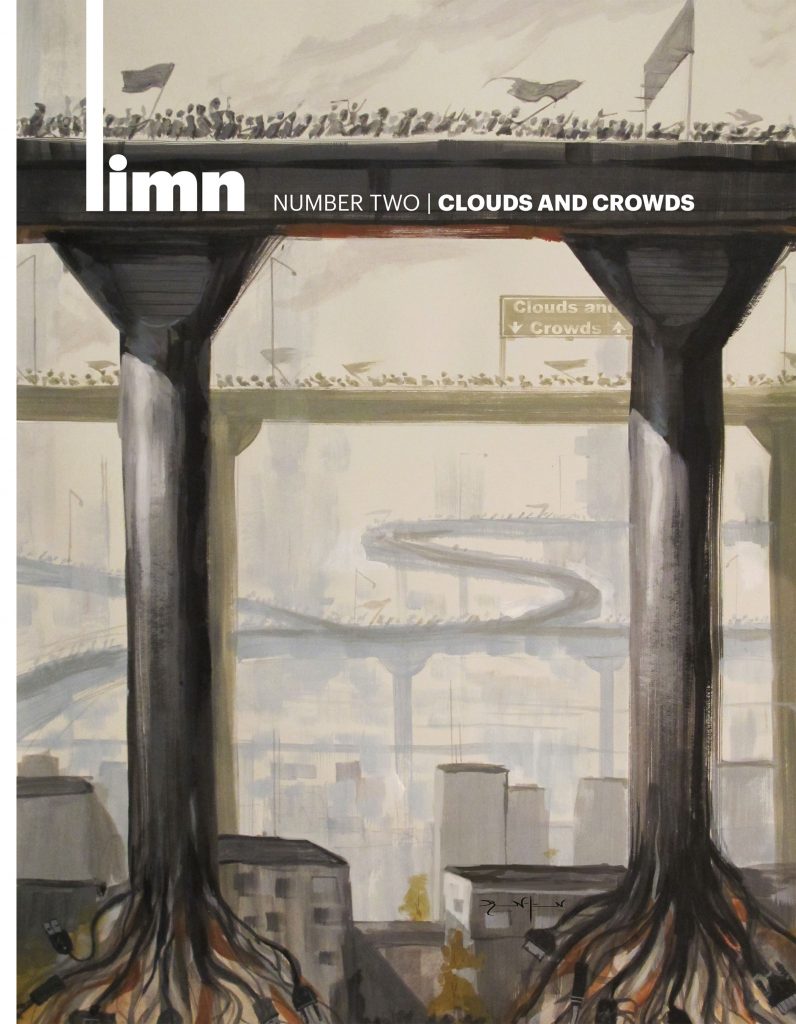Limn, 0-2: Prototyping Prototyping / Systemic Risk / Crowds and Clouds (2010-2012)
Filed under magazine | Tags: · big data, cloud computing, crowdsourcing, data mining, economy, financial crisis, internet, networks, politics, social media, surveillance

Limn, 0: Prototyping Prototyping, Nov 2010
“Before there was LIMN, there were several different prototypes. The first was occasioned by a conference: on prototypes. Held in Madrid in November of 2010, and organized by Adolpho Estalella and Alberto Corsín Jimenez, it was a conference for which this issue was imagined as a kind of pre-conference publication–another riff on the prototype. Many of the problems LIMN seeks to address were worked out in part through this conference and the publication: from the use of new media, to the function of conferences and conference papers, to the idea of a publication that precedes or determines a social event. Issue Number Zero was very much a prototype, and bears the traces of that concept and the discussion of it by the generous participants.”
Contributors: George Marcus, Marilyn Strathern, James Leach, Alberto Corsin Jimenez and Adolfo Estalella, Alex Wilkie, Nerea Calvillo, Javier Lezaun, Lucy Suchman, Lina Dib, Michael Guggenheim, Alain Pottage
HTML (updated on 2019-7-8)

Limn, 1: Systemic Risk, Jan 2011
“Systemic risk has become a central topic of expert discussion and political debate amidst the financial crisis that began in 2008, but it also has resonances across many other domains in which catastrophic threats loom – including internet security, supply chain management, catastrophe insurance, and critical infrastructure protection. In this issue, we invited scholars to contribute genealogical and conceptual framings that inform critical inquiry into this increasingly important concept. The result is not a traditional collection of academic articles but a set of brief, preliminary reflections, prepared on short notice, that address a common set of questions, along with a handful of documents, links, images and videos that illustrate different aspects of the concept.”
Contributors: Benjamin Sims, Deborah Cowen, Myriam Dunn Cavelty, Elizabeth Cullen Dunn, Christopher M. Kelty, Philip Bougen, Stephen J. Collier, Andrew Lakoff, Onur Ozgöde, Douglas R. Holmes, Rebecca Lemov, Brian Lindseth, Martha Poon, Grahame Thompson
HTML (updated on 2019-7-8)

Limn, 2: Crowds and Clouds, Mar 2012
“This issue of LIMN focuses on new social media, data mining and surveillance, crowdsourcing, cloud computing, big data, and Internet revolutions. Rather than follow the well-worn paths of argument typical today, our contributors address the problems in new ways and at odd angles: from the power and politics of statistics and algorithms to crowdsourcing’s discontents to the capriciousness of collectives in an election; from the focus group and the casino to the worlds of micro-finance and data-intensive policing. Together they raise questions about the relationship of technology and the collectives that form in and through them.”
Contributors: Christopher Kelty, Alain Desrosières, Lilly Irani, Chris Csikszentmihályi, Gabriella Coleman, Nick Seaver, Emmanuel Didier, Alek Felstiner, Tarleton Gillespie, Roma Jhaveri, Daniel Kreiss, Natasha Dow Schüll, Rebecca Lemov, Maria Vidart, Amira Pettus, Jonathan R. Baldwin, and Ruben Hickman
HTML (updated on 2019-7-8)
“Limn is somewhere between a scholarly journal and an art magazine. It is an attempt to communicate and display ongoing scholarly research. Limn outlines contemporary problems. It draws material from networks of experts in the social and human sciences and is intended to be timely, diverse in perspective, authoritative, well written and beautifully designed. The focus is on contemporary problems in our global, politically interconnected, technologically intense culture: problems of infrastructure, ecological vulnerability, economic interdependence, and relentless technological invention.”
Editors: Stephen J. Collier, Christopher M. Kelty, Andrew Lakoff
Creative Commons BY-SA 3.0 Unported License
Helen Nissenbaum, Kazys Varnelis: Situated Technologies Pamphlet 9: Modulated Cities: Networked Spaces, Reconstituted Subjects (2012)
Filed under book | Tags: · networks, privacy
The Situated Technologies Pamphlets series explores the implications of ubiquitous computing for architecture and urbanism. How is our experience of the city and the choices we make in it affected by mobile communications, pervasive media, and other “situated” technologies?
In Situated Technologies Pamphlets 9, Helen Nissenbaum and Kazys Varnelis initiate a redefinition of privacy in the age of big data and networked, geo-spatial environments. Digital technologies permeate our lives and make the walls of the built environment increasingly porous, no longer the hard boundary they once were when it comes to decisions about privacy. Data profiling, aggregation, analysis, and sharing are broad and hidden, making it harder than ever to constrain the flow of data about us. Cautioning that suffocating surveillance could lead to paralyzed dullness, Nissenbaum and Varnelis do not ask us to retreat from digital media but advance interventions like protest, policy changes, and re-design as possible counter-strategies.
Publisher Architectural League of New York, Spring 2012
Creative Commons Attribution 2.0 license
ISBN 978-0-9800994-8-5
56 pages
Alessandro Ludovico: Post-Digital Print: The Mutation of Publishing Since 1894 (2012–) [EN, IT]
Filed under book | Tags: · archive, book, e-book, filesharing, library, networks, print, publishing, reading, text, writing

“In the post-digital age, digital technology is no longer revolutionary but a normality, everywhere. For music or film, circulation as bits and bytes, downloads and streams are no longer a big deal. But for the world of book and magazine publishing, change has just begun.
New ways of networked and electronic publishing had been envisioned by avant-garde artists, activists and technologists for more than a century. Even though in hindsight the reports of the death of paper were greatly exaggerated, electronic publishing has now become a reality. How will analog and digital coexist in the post-digital age of publishing? How will they transition, mix and cross over?
In this book, Alessandro Ludovico rereads the history of avant-garde arts as a prehistory of cutting through the opposites of paper and electronics. He covers, among others, artists’ books and manifests, zines, net art and experimental publishing projects, up to e-readers and print-on-demand.”
With Afterword by Florian Cramer
Publisher Creating 010, Hogeschool Rotterdam & Onomatopee, Eindhoven, May 2012
Onomatopee 77: Cabinet Project
Creative Commons Attribution-NonCommercial-ShareAlike 3.0 Unported License
ISBN 9789078454878, 9078454873
192 pages
via Florian Cramer
Interview with author: Teresa de Andrés (VisualMag, 2012).
Reviews: Franz Thalmair (Springerin, 2012), Regine Debatty (We Make Money Not Art, 2013), Rob Myers (Furtherfield, 2013), Paul Prudence (Neural, 2013), brnrd.net (2013), Kate Cunningham (Yapp, 2014), Eloïse Cariou (Critique d’art, 2016, FR), Benjamin Caraco (BBF, 2017, FR).
Book launch (Eindhoven, 2012)
Post Digital Print (series of activities around the publication, 2012)
Book website
Publisher (EN)
Publisher (IT, archived)
WorldCat (EN)
Wikipedia
Post-Digital Print (English, 2012, updated on 2012-5-31 to the latest version of the book, Internet Archive)
Post-digital print. La mutazione dell’editoria dal 1894 (Italian, trans. Alessandro Ludovico and Rosa Antonicelli Verrelli, 2014, added on 2020-6-3)


